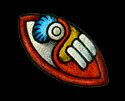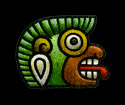Aztec and Maya Calendar
In the tonalpohualli, the sacred Aztec calendar, Wednesday July 17, 1996 is:
Xihuitl:
solar year


10 - Tecpatl (flint knife)
Xiuhpohualli:
365-day calendar
1 - Quecholli (XIV)
Long Count:
Mayan calendar
12.19.3.5.19
(Correlation: Alfonso Caso - Nicholson's veintena alignment [adjust])
The significance of this day
Day Quiahuitl (Rain, known as Cauac in Maya) is governed by Tonatiuh, the Sun God, as its provider of tonalli (Shadow Soul) life energy. Quiahuitl is a day of relying on the unpredictable fortunes of fate. It is a good day for traveling and learning, a bad day for business and planning.
The thirteen day period (trecena) that starts with day 1-Ozomahtli (Monkey) is ruled by Patecatl. The 13 days of this trecena are influenced by the quest for cures of all the various ills that befall us: the quest to obtain power that can overcome misfortune lies at the heart of the warrior's purpose. The transformation of poison into medicine, and evil into good, is an art whose expression must be tailored to the field of battle. These are good days to fashion a war shield and collect articles for your medicine bundle; bad days to allow infections to fester.
Aztec facts
In the years after the conquest of Mexico, the xiuhpohualli (solar calendar) became tied to the Julian calendar as used by the Spaniards. This effectively introduced a leap year to the Aztec calendar every four years (this site provides the pre-conquest calendar).



